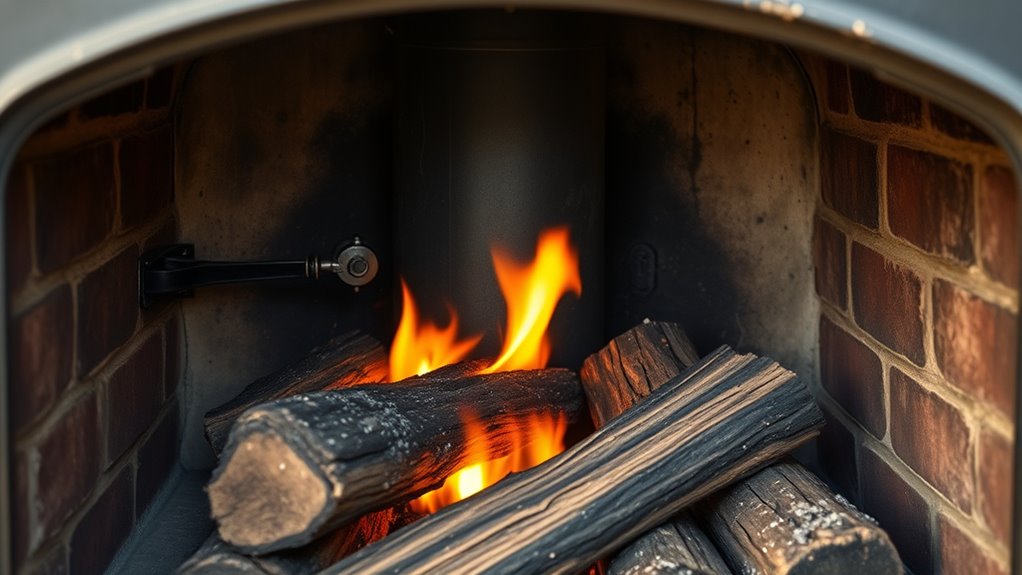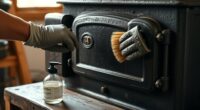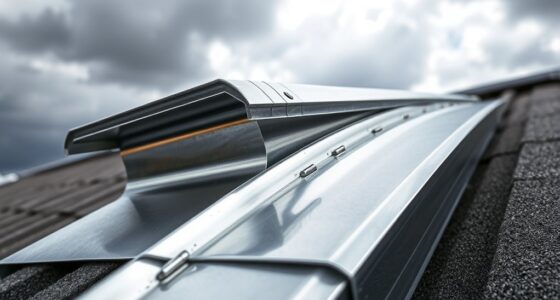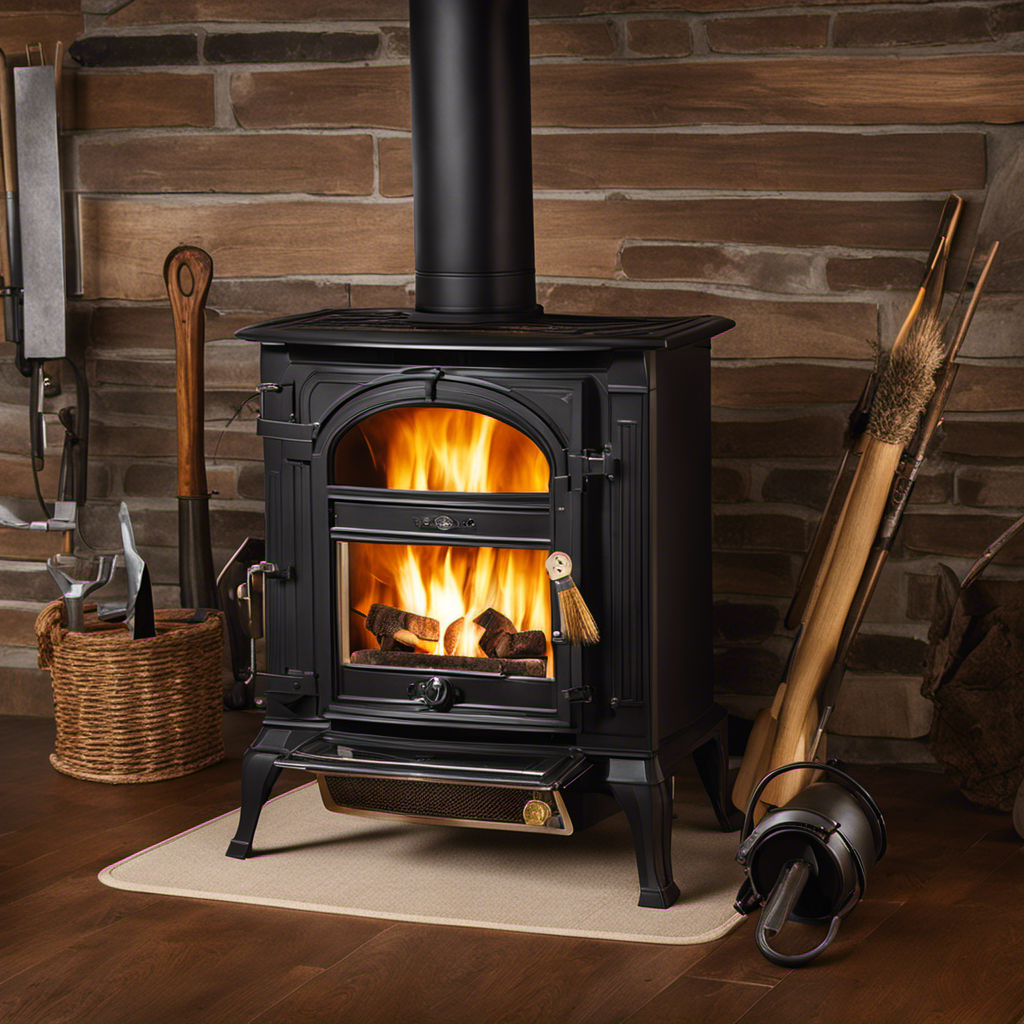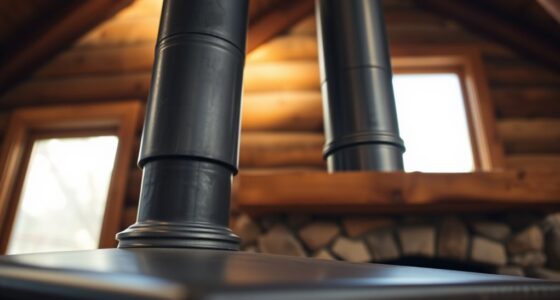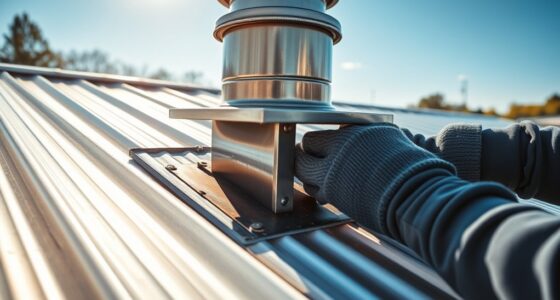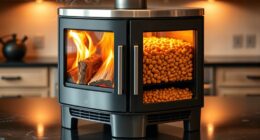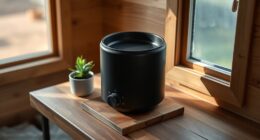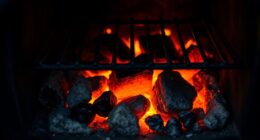If your wood stove isn’t drawing properly, check that your chimney is tall enough and extends above the roofline to improve airflow. Make sure you’re using dry, seasoned wood and starting fires correctly with fully open dampers. Inspect and clean your chimney for creosote or blockages, and ensure vents are fully open. External factors like wind or cold weather can also affect draw. Keep exploring to discover more tips to fix the issue.
Key Takeaways
- Ensure the chimney is tall enough (at least 3 ft above the roof) and properly extended to improve draft.
- Check that all dampers and air controls are fully open and functioning correctly.
- Inspect and clean the chimney and flue for creosote buildup, blockages, or debris.
- Confirm the chimney is clear of obstructions and properly vented outside, avoiding wind turbulence.
- Use dry, seasoned hardwood and start fires with proper top-down stacking for better airflow.
Assess and Optimize Chimney Height and Configuration
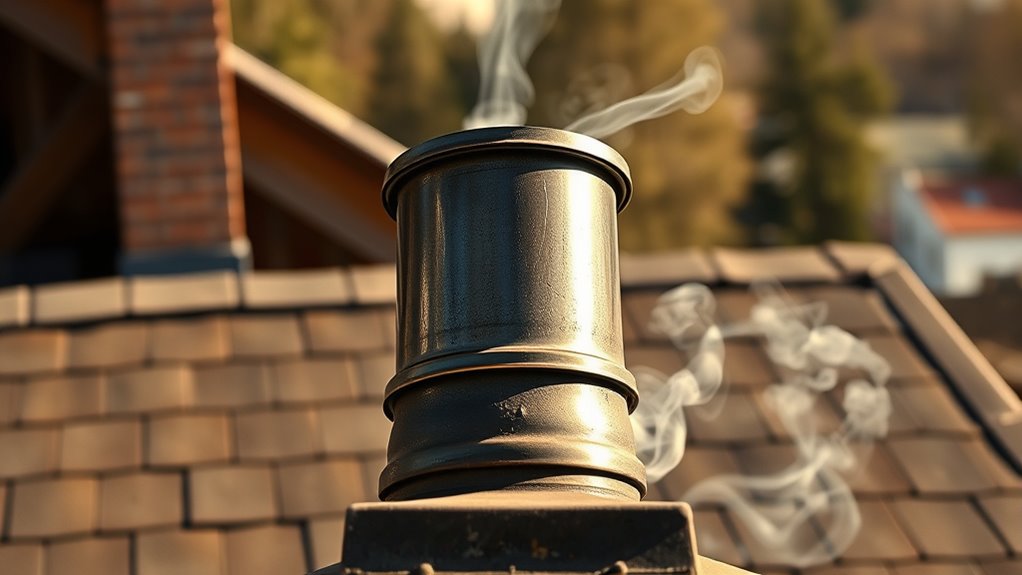
To improve your wood stove’s draft, start by evaluating the chimney’s height and placement. A taller chimney, ideally 15 feet or more, boosts draft by increasing airflow and creating a greater temperature difference. Proper chimney height helps overcome wind shadows caused by nearby structures like trees or buildings, which can obstruct airflow. Extending the chimney above the roofline, at least 2 feet above any obstacle within 10 feet, reduces backpressure and promotes better smoke venting. Ensuring the chimney’s height matches local codes and your stove’s size prevents smoke spillage and improves combustion. If your chimney isn’t tall enough, consider adding an extension or a taller pipe section to enhance airflow, improve draft, and prevent downdrafts. Correct height and placement are key to ideal performance. Additionally, using draft enhancers like chimney fans or adjusting the damper can further improve airflow and combustion efficiency. Properly maintaining and inspecting your chimney for blockages, creosote buildup, and proper insulation also ensures optimal performance and safe operation.
Ensure Proper Fire Starting Techniques and Wood Quality
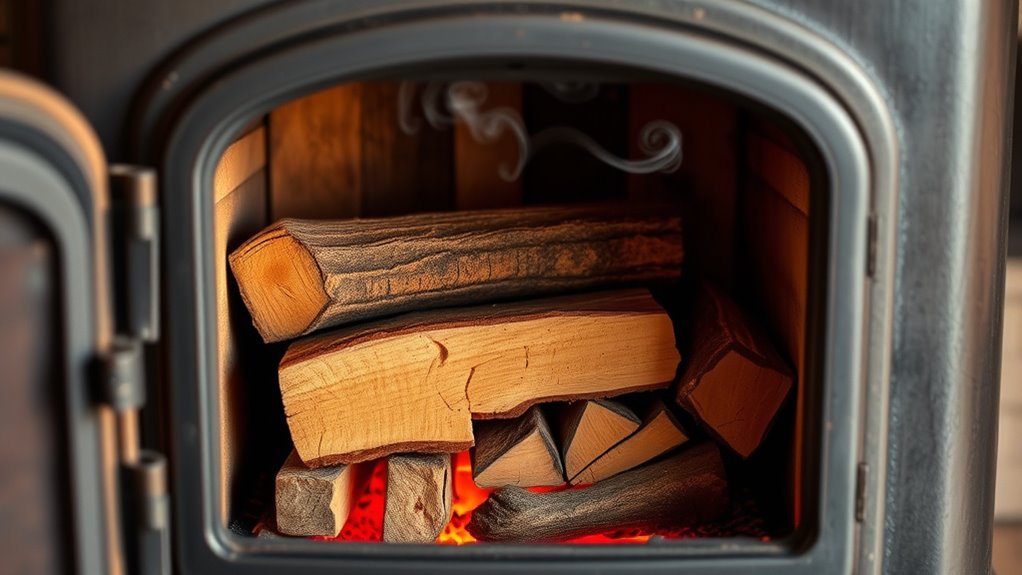
Starting your fire correctly and using high-quality wood are essential for establishing a strong draft in your wood stove. Use dry, seasoned hardwood like oak or maple with moisture content below 20% to guarantee efficient ignition and better airflow. Begin your fire with a top-down method, stacking larger logs on top so the fire ignites from above, producing immediate heat. Make sure the initial fire is hot and vigorous by fully opening the damper, which helps create a strong draft and improves air intake. Avoid green or unseasoned wood, as high moisture levels lead to excess smoke and hinder proper draft. Always store your wood in a well-ventilated, covered area off the ground for 1-2 years to maintain ideal dryness and combustion. Proper electric power generation from your stove’s draft can also assist in establishing better airflow, as the right amount of power can help sustain a consistent draft.
Check and Maintain Airflow and Ventilation Conditions
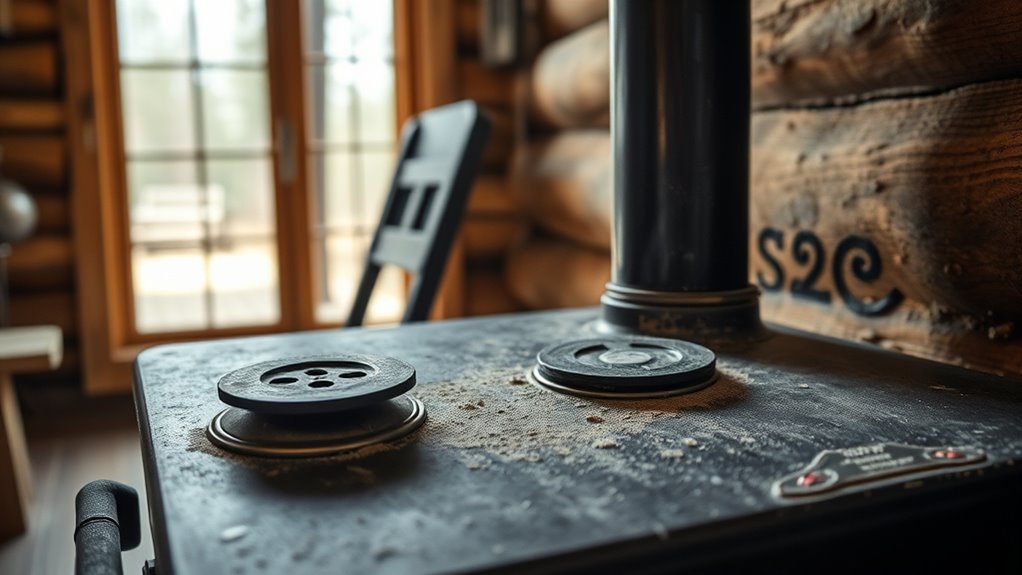
Making certain proper airflow and ventilation is crucial for a wood stove to draw effectively. Without adequate airflow, smoke and gases won’t vent properly, reducing draft. To improve this, check these key areas:
- Make sure all air controls and dampers are fully open and working correctly to allow sufficient combustion airflow.
- Verify the chimney and flue are clear of blockages, creosote buildup, or obstructions that could restrict the draft.
- Ensure proper room ventilation by cracking a window or door to supply fresh outside air, especially in airtight homes.
- External factors like wind, outdoor temperature, or house pressure can also influence the chimney’s draft. Addressing these elements enhances airflow and ensures your wood stove draws efficiently. Proper ventilation can significantly improve your stove’s performance, and maintaining good airflow throughout your home can help prevent draft issues. Additionally, ensuring the dog names are well-maintained can help create a more comfortable environment that supports proper ventilation. Regularly inspecting and cleaning your chimney and flue is essential to prevent blockages that hinder draft and to keep your stove operating safely and efficiently. A thorough inspection of the entire ventilation system can help identify hidden issues before they impact performance.
Inspect and Clean the Chimney and Flue System
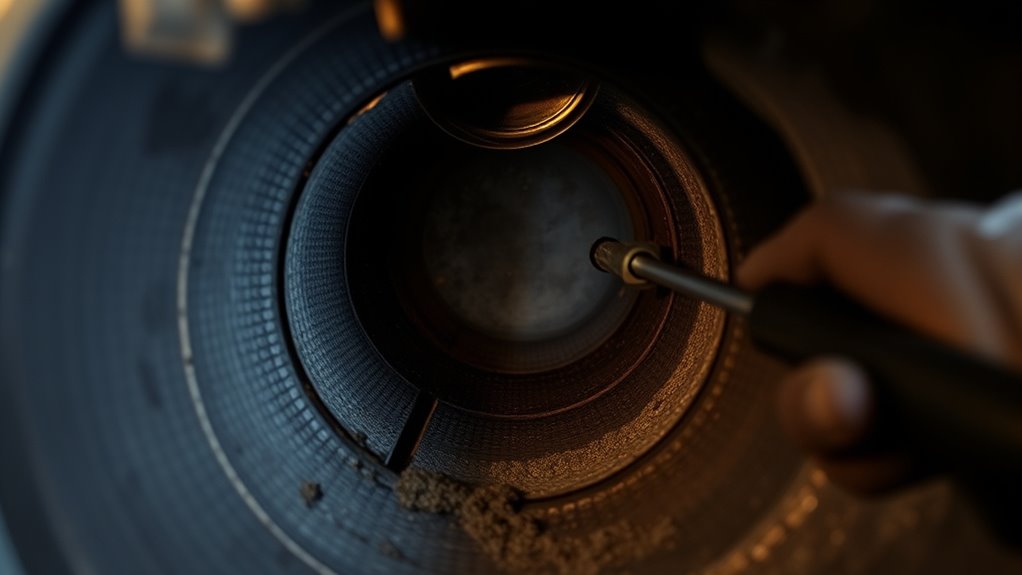
Regularly inspecting and cleaning your chimney and flue system keeps airflow unobstructed and prevents draft issues. Start by checking for creosote buildup, bird nests, or debris blocking the chimney or flue. Use tools like a chimney brush or professional sweep to remove soot and creosote from the walls. Confirm that the chimney cap and cleanout tee are clear of obstructions. Inspect the flue pipe for blockages or gaps, and ensure the chimney liner is intact and properly sized. Proper height—about 3 feet above the roof—is essential for good draft. Additionally, understanding the Volkswagen Tuning can help create a more relaxing environment while maintaining your stove area.
Address External Factors and Consider Professional Evaluation
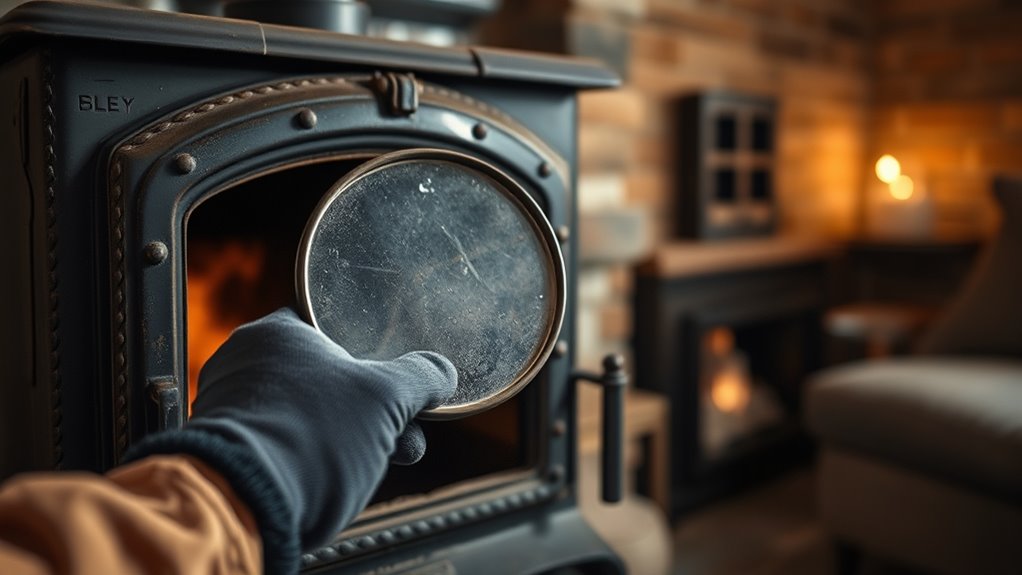
External factors like wind, nearby buildings, and weather conditions can markedly impact your chimney’s draft, leading to smoke spillage or poor combustion. These external obstructions can disrupt airflow and reduce chimney draft efficiency. To address this, consider these points:
- Tall structures or trees near your chimney can cause wind turbulence, affecting draft stability.
- Low chimney height or improper extension can hinder proper airflow, especially in cold weather.
- Cold outdoor temperatures cool the flue, decreasing buoyancy and leading to poor draft or smoke backflow.
- Ensuring your stove installation complies with safety standards and proper venting practices can significantly improve draft performance.
- Regularly inspecting and maintaining your chimney cap can prevent blockages and enhance airflow efficiency.
- Weather conditions such as high humidity or rapid temperature changes can also affect the draft, as they influence the air pressure around your chimney.
- External conditions like wind turbulence are particularly impactful and may require additional measures such as chimney caps or screens to reduce their effects.
If these external factors seem to be the cause, a professional inspection is essential. A professional can identify external obstructions, damage to the cap, or placement issues that impair draft, helping you implement effective solutions.
Frequently Asked Questions
What Would Cause a Wood Stove Not to Draw?
If your wood stove isn’t drawing properly, it’s likely due to issues like insufficient chimney height, which prevents proper airflow. Blockages such as creosote buildup, bird nests, or debris inside the flue can restrict draft. External factors like wind shadows or cold weather also play a role. Make sure the chimney is correctly sized, sealed, and free of obstructions to improve your stove’s draw and ensure safe, efficient burning.
How to Fix a Chimney That Won’t Draw?
Oh, so your chimney’s decided to go on strike? First, make certain it’s tall enough—15 feet or more—so it can do its job. Clear out any bird nests, creosote, or debris blocking airflow. Double-check all connections and that the flue matches your stove. Preheat the chimney with a heat source, and if needed, extend it higher. With these steps, your chimney should start behaving properly again.
Why Is My Wood Stove Down Drafting?
When your wood stove is down drafting, you’re dealing with smoke and gases flowing back into your room instead of rising outside. This often happens because cold, dense air in the chimney creates negative pressure, especially if the chimney is too short or obstructed. External factors like wind shadows, a cold chimney liner, or creosote buildup can also disrupt the draft, causing smoke to spill back into your living space.
Why Won’t My Stove Draw?
When your stove won’t draw, it’s usually due to insufficient airflow or obstructions. Check that your chimney is tall enough, free of blockages, and free of creosote buildup. Make sure the stovepipe connections are correctly installed and properly sized. External factors like wind or cold weather can also reduce draft. Ensuring proper installation and regular cleaning often restores the proper draft, helping your stove burn efficiently.
Conclusion
By following these steps, you can often fix your wood stove’s drawing issues yourself. Remember to assess chimney height, use quality wood, and keep vents clear. Regular cleaning and considering external factors can also make a big difference. When was the last time you gave your chimney a thorough inspection? Taking these simple actions can restore your stove’s performance and keep your home warm and cozy all season long. Isn’t it worth a little effort for a cozy fire?

